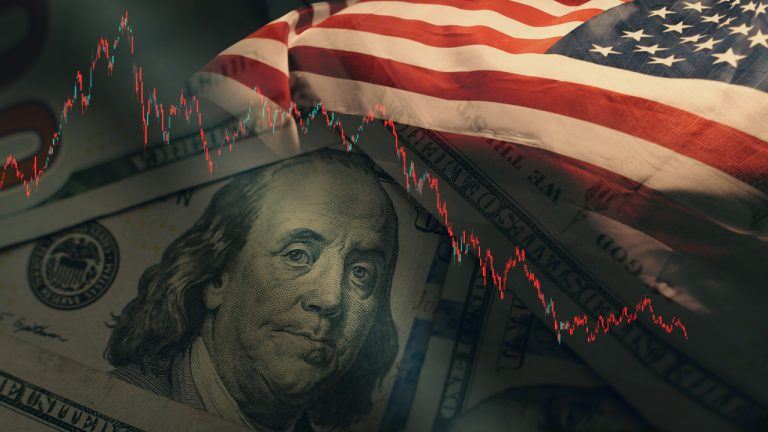 Goldman Sachs CEO David Solomon expects the Federal Reserve to delay any emergency rate cuts until at least September despite weak job data, believing the U.S. economy will avoid a recession. Speaking on “The David Rubenstein Show,” Solomon indicated that while investors had anticipated potential rate cuts before the September meeting due to global market […]
Goldman Sachs CEO David Solomon expects the Federal Reserve to delay any emergency rate cuts until at least September despite weak job data, believing the U.S. economy will avoid a recession. Speaking on “The David Rubenstein Show,” Solomon indicated that while investors had anticipated potential rate cuts before the September meeting due to global market […]

Pear Protocol founder HUF says “a limited pool of capital constantly rotating between narratives” is a clear sign of “late cycle behavior.”
Global markets blew up over the weekend, and the onslaught carried on throughout the trading day on Aug. 5 as the DOW and S&P 500 dropped by more than 1,000 points and Bitcoin (BTC) price fell below $49,000. Japan’s Nikkei 225 index saw its worst one-day correction since October 1987, and the sell-off in Taiwan’s benchmark stock index was the worst trading day in 57 years.
Nearly all markets closed Aug.5 in the red, and while it seems too early to conclude that the selling is over, traders are likely wondering whether or not it’s time to start thinking like a contrarian and handpicking assets at a discount?
To discuss what’s happening in this week’s volatile market, Cointelegraph spoke to Huf, the founder of Pear Protocol, a decentralized exchange that allows traders to engage in trending narratives via pair trading.
 Coinshares, a digital asset investment firm, has reported a significant $528 million outflow from its crypto products last week, driven by growing recession fears. This substantial withdrawal reflects the heightened market uncertainty and investor caution amid economic downturn concerns. Despite this setback, Coinshares remains committed to its long-term strategy and continues to expand its operations […]
Coinshares, a digital asset investment firm, has reported a significant $528 million outflow from its crypto products last week, driven by growing recession fears. This substantial withdrawal reflects the heightened market uncertainty and investor caution amid economic downturn concerns. Despite this setback, Coinshares remains committed to its long-term strategy and continues to expand its operations […] Global investment bank Goldman Sachs has increased the likelihood of a U.S. recession within the next year to 25% from the previous 15%, although they maintain that the risk remains limited. Despite the recent rise in unemployment to its highest in nearly three years and a significant slowdown in hiring, Goldman economists, led by Jan […]
Global investment bank Goldman Sachs has increased the likelihood of a U.S. recession within the next year to 25% from the previous 15%, although they maintain that the risk remains limited. Despite the recent rise in unemployment to its highest in nearly three years and a significant slowdown in hiring, Goldman economists, led by Jan […]

A rapid decline in the traditional markets has spread to cryptocurrencies, obliterating them with a significant drop in all major assets. What are the possible factors for this perfect storm?
On Aug. 2, $2.9 trillion vanished from the stock markets, resulting in the worst day of trading since the COVID-19 crash in 2020. Mounting recession fears and other factors have also plunged the crypto markets, flooding the sentiment with fear.
Bitcoin (BTC) has dropped by 27%, Ether (ETH) by 34%, and more than $1.13 billion in futures positions have been liquidated. The last-day market action has dramatically changed the Fear & Greed Index from greed (74) to fear (26), very close to extreme fear.
The CBOE Volatility Index (VIX), which measures stock market volatility based on S&P 500 index options, reached 65, the highest level since the pandemic crash. This indicates that markets could enter an extreme turbulence phase. The reasons for this downfall are not crypto-specific but clearly affect Bitcoin and especially the altcoin market.

As Bitcoin dropped below $50,000, analysts expect more outflows that would potentially drive prices down to $42,000.
Cryptocurrency assets started seeing significant outflows last week amid growing fears of a recession in the United States and geopolitical concerns, according to a new report by the crypto investment firm CoinShares.
The week of July 28 to Aug. 3 saw digital asset investment products posting outflows for the first time in four weeks totalling $528 million, CoinShares reported in its latest digital asset fund flows report published on Aug. 5.
CoinShares noted that the latest crypto sell-off is believed to be a reaction to fears of a recession in the US, geopolitical uncertainty and consequent broader market liquidations across the majority of assets.
 At the end of the week, U.S. equities experienced a sharp decline, which reverberated through the cryptocurrency market, reducing its value from $2.4 trillion to $2.09 trillion since July 29. Recently, discussions have intensified around the likelihood of an impending U.S. recession, with a soft landing seemingly off the table. Below are six distinct indicators […]
At the end of the week, U.S. equities experienced a sharp decline, which reverberated through the cryptocurrency market, reducing its value from $2.4 trillion to $2.09 trillion since July 29. Recently, discussions have intensified around the likelihood of an impending U.S. recession, with a soft landing seemingly off the table. Below are six distinct indicators […] Despite recent positive economic indicators, investor and macroeconomics expert George Gammon foresees a hard landing for the U.S. economy. In an interview with Michelle Makori of Kitco News, Gammon pointed to several warning signs in the banking sector and the broader financial landscape. Banks See Economic Storm Clouds Ahead: George Gammon’s Warning Gammon explains that […]
Despite recent positive economic indicators, investor and macroeconomics expert George Gammon foresees a hard landing for the U.S. economy. In an interview with Michelle Makori of Kitco News, Gammon pointed to several warning signs in the banking sector and the broader financial landscape. Banks See Economic Storm Clouds Ahead: George Gammon’s Warning Gammon explains that […]

Bitcoin’s price continues to correct, but BTC options markets reflect traders’ interest in the $62,000 level.
Bitcoin (BTC) price plunged 5.5% between July 31 and Aug. 1, reaching its lowest level in over two weeks at $62,498. This movement has been attributed to reduced expectations of interest rate cuts in the United States and the distribution of 47,000 BTC from the estate of defunct exchange Mt. Gox. Traders fear that Bitcoin’s price could further correct to retest the $57,000 support level, but derivatives markets show resilience and no signs of stress.
On July 31, the United States Federal Open Market Committee announced its decision to leave interest rates unchanged at 5.25%, aligning with market expectations. Fed Chair Jerome Powell cited solid signs of gross domestic product expansion and confidence in the current rate of inflation reduction, potentially supporting a rate cut in September. In short, Powell’s statement suggests a more cautious approach to rate cuts.
Investors increased their bets in US Treasurys, causing the five-year yield to reach its lowest level in six months. Part of this movement can be explained by escalating tensions in the Middle East, leading traders to seek protection in the asset deemed safest. Another confirmation of this theory comes from the precious metal gold, as its price increased to $2,450, just 1.5% below its all-time high.
 New research by Affirm reveals three in five Americans believe the U.S. is in a recession, though it’s not officially declared. A survey of 2,000 people shows inflation and rising living costs (68%) as the main reasons for this belief, followed by complaints from friends and family (50%), reduced spending by peers (36%), and difficulties […]
New research by Affirm reveals three in five Americans believe the U.S. is in a recession, though it’s not officially declared. A survey of 2,000 people shows inflation and rising living costs (68%) as the main reasons for this belief, followed by complaints from friends and family (50%), reduced spending by peers (36%), and difficulties […]